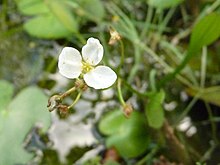bio.wikisort.org - Plant
Sagittaria pygmaea, commonly known as the dwarf arrowhead or pygmy arrowhead,[2] is an aquatic plant species. It is native to Japan (including the Ryukyu Islands), Korea, Taiwan, Thailand, Vietnam, Bhutan and China (Anhui, Fujian, Guangdong, Guangxi, Guizhou, Hainan, Henan, Hubei, Hunan, Jiangsu, Jiangxi, Shaanxi, Shandong, Sichuan, Yunnan, Zhejiang).[1][3]
| Sagittaria pygmaea | |
|---|---|
 | |
| Scientific classification | |
| Kingdom: | Plantae |
| Clade: | Tracheophytes |
| Clade: | Angiosperms |
| Clade: | Monocots |
| Order: | Alismatales |
| Family: | Alismataceae |
| Genus: | Sagittaria |
| Species: | S. pygmaea |
| Binomial name | |
| Sagittaria pygmaea | |
| Synonyms[1] | |
| |
Sagittaria pygmaea grows in shallow water in marshes, channels and rice paddies. It is a perennial herb producing by means of stolons. Leaves are linear to slightly spatula-shaped, not lobed, up to 30 centimetres (12 in) long.[3][4][5][6]
References
- "Sagittaria pygmaea". World Checklist of Selected Plant Families (WCSP). Royal Botanic Gardens, Kew. Retrieved 2017-01-30.
- "Sagittaria pygmaea". Germplasm Resources Information Network (GRIN). Agricultural Research Service (ARS), United States Department of Agriculture (USDA). Retrieved 2017-02-09.
- "Sagittaria pygmaea in Flora of China @ efloras.org". www.efloras.org. Retrieved 2017-01-30.
- (Netherlands), Rijksherbarium; Wilhelm, Miquel, Friedrich Anton. "Annales Musei botanici lugduno-batavi". v.2 (1865-1866).
{{cite journal}}: Cite journal requires|journal=(help) - Gakkai, Nihon Shokubutsu; Gakkai, Tåokyåo Shokubutsu; Gakkai, Tokyo Shokubutsu (1902-01-01). "The Botanical Magazine". Botanical Magazine Tokyo. v.16 (1902). ISSN 0006-808X.
- Nakai, Takenoshin (1943). Journal of Japanese Botany. [Shokubutsu Kenkyu Zasshi]. Tokyo 19:247. "Blyxa coreana".
Текст в блоке "Читать" взят с сайта "Википедия" и доступен по лицензии Creative Commons Attribution-ShareAlike; в отдельных случаях могут действовать дополнительные условия.
Другой контент может иметь иную лицензию. Перед использованием материалов сайта WikiSort.org внимательно изучите правила лицензирования конкретных элементов наполнения сайта.
Другой контент может иметь иную лицензию. Перед использованием материалов сайта WikiSort.org внимательно изучите правила лицензирования конкретных элементов наполнения сайта.
2019-2025
WikiSort.org - проект по пересортировке и дополнению контента Википедии
WikiSort.org - проект по пересортировке и дополнению контента Википедии